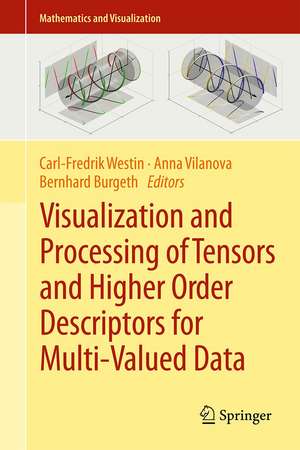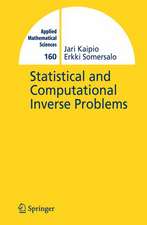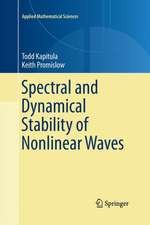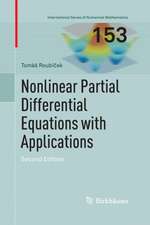Visualization and Processing of Tensors and Higher Order Descriptors for Multi-Valued Data: Mathematics and Visualization
Editat de Carl-Fredrik Westin, Anna Vilanova, Bernhard Burgethen Limba Engleză Hardback – aug 2014
Part I, Tensor Data Visualization, surveys techniques for visualization of tensors and tensor fields in engineering, discusses the current state of the art and challenges, and examines tensor invariants and glyph design, including an overview of common glyphs.
The second Part, Representation and Processing of Higher-order Descriptors, describes a matrix representation of local phase, outlines mathematical morphological operations techniques, extended for use in vector images, and generalizes erosion to the space of diffusion weighted MRI.
Part III, Higher Order Tensors and Riemannian-Finsler Geometry, offers powerful mathematical language to model and analyze large and complex diffusion data such as High Angular Resolution Diffusion Imaging (HARDI) and Diffusion Kurtosis Imaging (DKI).
A Part entitled Tensor Signal Processing presents new methods for processing tensor-valued data, including a novel perspective on performing voxel-wise morphometry of diffusion tensor data using kernel-based approach, explores the free-water diffusion model, and reviews proposed approaches for computing fabric tensors, emphasizing trabecular bone research.
The last Part, Applications of Tensor Processing, discusses metric and curvature tensors, two of the most studied tensors in geometry processing. Also covered is a technique for diagnostic prediction of first-episode schizophrenia patients based on brain diffusion MRI data. The last chapter presents an interactive system integrating the visual analysis of diffusion MRI tractography with data from electroencephalography.
| Toate formatele și edițiile | Preț | Express |
|---|---|---|
| Paperback (1) | 990.12 lei 6-8 săpt. | |
| Springer Berlin, Heidelberg – 23 aug 2016 | 990.12 lei 6-8 săpt. | |
| Hardback (1) | 894.50 lei 38-44 zile | |
| Springer Berlin, Heidelberg – aug 2014 | 894.50 lei 38-44 zile |
Din seria Mathematics and Visualization
- 20%
 Preț: 935.20 lei
Preț: 935.20 lei -
 Preț: 256.43 lei
Preț: 256.43 lei - 18%
 Preț: 960.93 lei
Preț: 960.93 lei - 18%
 Preț: 1110.41 lei
Preț: 1110.41 lei - 24%
 Preț: 800.85 lei
Preț: 800.85 lei - 15%
 Preț: 654.62 lei
Preț: 654.62 lei - 18%
 Preț: 1220.57 lei
Preț: 1220.57 lei - 20%
 Preț: 997.38 lei
Preț: 997.38 lei - 20%
 Preț: 994.26 lei
Preț: 994.26 lei - 15%
 Preț: 645.47 lei
Preț: 645.47 lei - 20%
 Preț: 1284.47 lei
Preț: 1284.47 lei - 20%
 Preț: 656.69 lei
Preț: 656.69 lei - 20%
 Preț: 476.68 lei
Preț: 476.68 lei - 20%
 Preț: 1273.08 lei
Preț: 1273.08 lei - 15%
 Preț: 649.54 lei
Preț: 649.54 lei - 20%
 Preț: 335.36 lei
Preț: 335.36 lei - 20%
 Preț: 646.95 lei
Preț: 646.95 lei - 20%
 Preț: 651.75 lei
Preț: 651.75 lei - 20%
 Preț: 657.99 lei
Preț: 657.99 lei - 18%
 Preț: 1223.74 lei
Preț: 1223.74 lei - 20%
 Preț: 709.98 lei
Preț: 709.98 lei - 20%
 Preț: 333.72 lei
Preț: 333.72 lei - 5%
 Preț: 1101.58 lei
Preț: 1101.58 lei - 20%
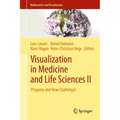 Preț: 992.44 lei
Preț: 992.44 lei - 18%
 Preț: 1236.38 lei
Preț: 1236.38 lei - 20%
 Preț: 1158.59 lei
Preț: 1158.59 lei - 20%
 Preț: 330.66 lei
Preț: 330.66 lei - 20%
 Preț: 992.26 lei
Preț: 992.26 lei - 20%
 Preț: 648.44 lei
Preț: 648.44 lei - 18%
 Preț: 963.91 lei
Preț: 963.91 lei - 15%
 Preț: 653.98 lei
Preț: 653.98 lei - 20%
 Preț: 991.94 lei
Preț: 991.94 lei - 18%
 Preț: 958.07 lei
Preț: 958.07 lei
Preț: 894.50 lei
Preț vechi: 1118.11 lei
-20% Nou
Puncte Express: 1342
Preț estimativ în valută:
171.19€ • 176.60$ • 144.88£
171.19€ • 176.60$ • 144.88£
Carte tipărită la comandă
Livrare economică 01-07 martie
Preluare comenzi: 021 569.72.76
Specificații
ISBN-13: 9783642543005
ISBN-10: 3642543006
Pagini: 360
Ilustrații: XV, 343 p. 110 illus., 85 illus. in color.
Dimensiuni: 155 x 235 x 25 mm
Greutate: 0.68 kg
Ediția:2014
Editura: Springer Berlin, Heidelberg
Colecția Springer
Seria Mathematics and Visualization
Locul publicării:Berlin, Heidelberg, Germany
ISBN-10: 3642543006
Pagini: 360
Ilustrații: XV, 343 p. 110 illus., 85 illus. in color.
Dimensiuni: 155 x 235 x 25 mm
Greutate: 0.68 kg
Ediția:2014
Editura: Springer Berlin, Heidelberg
Colecția Springer
Seria Mathematics and Visualization
Locul publicării:Berlin, Heidelberg, Germany
Public țintă
ResearchCuprins
Part I: Tensor Data Visualization: Top Challenges in the Visualization of Engineering Tensor Fields: M Hlawitschka et al.- Tensor Invariants and Glyph Design: A. Kratz et al.- Part II: Representation and Processing of Higher-order Descriptors: Monomial Phase: A Matrix Representation of Local Phase: H. Knutsson et al.- Order Based Morphology for Colour Images via Matrix Fields: B. Burgeth et al.- Sharpening Fibers in Diffusion Weighted MRI via Erosion: T.C.J. Dela Haije et al.- Part III: Higher Order Tensors and Riemannian-Finsler Geometry: Higher-Order Tensors in Diffusion Imaging: Thomas Schultz et al.- 4th Order Symmetric Tensors and Positive ADC Modelling: A. Ghosh et al.- Riemann-Finsler Geometry for Diffusion Weighted Magnetic Resonance Imaging: L.Florack et al.- Riemann-Finsler Multi-Valued Geodesic Tractography for HARDI: N.Sepasian et al.- Part IV: Tensor Signal Processing: Kernel-based Morphometry of Diffusion Tensor Images: M. Ingalhalikar et al.- The Estimation of Free-Water Corrected Diffusion Tensors: O. Pasternak et al.- Techniques for Computing Fabric Tensors: A Review: R. Moreno et al.- Part V: Applications of tensor processing: Tensors in Geometry Processing: E. Zhang.- Preliminary findings in diagnostic prediction of schizophrenia using diffusion tensor imaging: Y.Rathi et al.- A System for Combined Visualization of EEG and Diffusion Tensor Imaging TractographyData: A. Wiebel et al.
Textul de pe ultima copertă
Arising from the fourth Dagstuhl conference entitled Visualization and Processing of Tensors and Higher Order Descriptors for Multi-Valued Data (2011), this book offers a broad and vivid view of current work in this emerging field. Topics covered range from applications of the analysis of tensor fields to research on their mathematical and analytical properties.
Part I, Tensor Data Visualization, surveys techniques for visualization of tensors and tensor fields in engineering, discusses the current state of the art and challenges, and examines tensor invariants and glyph design, including an overview of common glyphs.
The second Part, Representation and Processing of Higher-order Descriptors, describes a matrix representation of local phase, outlines mathematical morphological operations techniques, extended for use in vector images, and generalizes erosion to the space of diffusion weighted MRI.
Part III, Higher Order Tensors and Riemannian-Finsler Geometry, offers powerful mathematical language to model and analyze large and complex diffusion data such as High Angular Resolution Diffusion Imaging (HARDI) and Diffusion Kurtosis Imaging (DKI).
A Part entitled Tensor Signal Processing presents new methods for processing tensor-valued data, including a novel perspective on performing voxel-wise morphometry of diffusion tensor data using kernel-based approach, explores the free-water diffusion model, and reviews proposed approaches for computing fabric tensors, emphasizing trabecular bone research.
The last Part, Applications of Tensor Processing, discusses metric and curvature tensors, two of the most studied tensors in geometry processing. Also covered is a technique for diagnostic prediction of first-episode schizophrenia patients based on brain diffusion MRI data. The last chapter presents an interactive system integrating the visual analysis of diffusion MRI tractographywith data from electroencephalography.
Part I, Tensor Data Visualization, surveys techniques for visualization of tensors and tensor fields in engineering, discusses the current state of the art and challenges, and examines tensor invariants and glyph design, including an overview of common glyphs.
The second Part, Representation and Processing of Higher-order Descriptors, describes a matrix representation of local phase, outlines mathematical morphological operations techniques, extended for use in vector images, and generalizes erosion to the space of diffusion weighted MRI.
Part III, Higher Order Tensors and Riemannian-Finsler Geometry, offers powerful mathematical language to model and analyze large and complex diffusion data such as High Angular Resolution Diffusion Imaging (HARDI) and Diffusion Kurtosis Imaging (DKI).
A Part entitled Tensor Signal Processing presents new methods for processing tensor-valued data, including a novel perspective on performing voxel-wise morphometry of diffusion tensor data using kernel-based approach, explores the free-water diffusion model, and reviews proposed approaches for computing fabric tensors, emphasizing trabecular bone research.
The last Part, Applications of Tensor Processing, discusses metric and curvature tensors, two of the most studied tensors in geometry processing. Also covered is a technique for diagnostic prediction of first-episode schizophrenia patients based on brain diffusion MRI data. The last chapter presents an interactive system integrating the visual analysis of diffusion MRI tractographywith data from electroencephalography.
Caracteristici
Discusses challenges in both theoretical and practical issues related to analyzing and visualizing fields of tensors and higher order descriptors Provides examples of tensors as applied to research in engineering and brain connectivity Multidisciplinary approach is intended to inspire and advance new research on analyzing and visualizing fields of tensors and higher order descriptors
